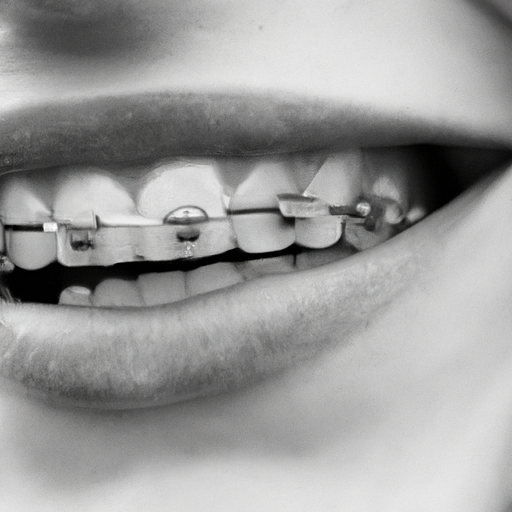Clear braces have revolutionized the field of orthodontics, offering patients a discreet and convenient alternative to traditional metal braces. In this comprehensive guide, we will delve into the world of clear braces, discussing their diagnosis, treatment options, symptoms, causes, and more. From understanding the basics of clear braces to exploring the benefits they offer, this article aims to provide a wealth of information for those considering orthodontic treatment. Whether you are seeking a solution for dental misalignment or simply curious about the advancements in orthodontic care, this guide will provide you with a closer look at the world of clear braces.
1. "Understanding Clear Braces: A Comprehensive Guide to Diagnosis and Treatment"
Clear braces have revolutionized the field of orthodontics, offering patients a discreet and convenient way to straighten their teeth. Unlike traditional metal braces, clear braces are virtually invisible, making them an appealing choice for individuals of all ages who are seeking a more aesthetically pleasing orthodontic treatment. In this comprehensive guide, we will delve into the diagnosis and treatment of clear braces, as well as discuss symptoms, causes, and other essential information.
Diagnosis plays a crucial role in determining whether clear braces are a suitable option for an individual. Typically, the first step is to consult with an orthodontist who will thoroughly examine the patient's teeth and bite alignment. The orthodontist may also take X-rays or use other diagnostic tools to assess the overall dental condition. This comprehensive evaluation helps the orthodontist determine if clear braces are the right choice for the patient's specific needs.
Once a diagnosis is made, the orthodontist will discuss the treatment plan with the patient. Clear braces are custom-made to fit each patient's teeth, ensuring a precise and comfortable fit. The treatment duration varies depending on the complexity of the case, but generally, it ranges from several months to a few years. During this time, the patient will need to visit the orthodontist regularly for adjustments and progress checks.
One of the significant advantages of clear braces is their discreet appearance. Made from translucent materials, they blend in with the natural tooth color, making them hardly noticeable. This feature is particularly appealing to individuals who wish to straighten their teeth without drawing attention to their orthodontic treatment. Clear braces are an excellent option for adults, teenagers, or anyone who desires a more subtle alternative to traditional braces.
Symptoms that may indicate the need for orthodontic treatment include crowded or crooked teeth, irregular spacing, overbite, underbite, crossbite, or an open bite. These issues can affect not only the appearance of one's smile but also overall oral health. Misaligned teeth can lead to difficulties in maintaining proper oral hygiene, increased risk of tooth decay and gum disease, as well as jaw pain and discomfort. Clear braces offer a solution to these problems, helping to align the teeth and improve both aesthetics and functionality.
The causes of misaligned teeth
2. "Recognizing the Symptoms and Causes of Dental Misalignment: How Clear Braces Can Help"
Dental misalignment is a common problem that affects people of all ages. It can cause a range of issues, including difficulty in proper chewing, speech problems, and a negative impact on one's self-esteem. While traditional metal braces have been the go-to treatment for correcting dental misalignment, clear braces have emerged as a more discreet and convenient alternative.
Recognizing the symptoms of dental misalignment is essential in understanding when it is necessary to seek treatment. Some common symptoms include crooked or crowded teeth, gaps between teeth, an overbite or underbite, difficulty in biting or chewing, and jaw pain. If you experience any of these symptoms, it is crucial to consult with an orthodontist who can evaluate your condition and recommend the most suitable treatment option.
There are various causes of dental misalignment. Genetics play a significant role, as the size and shape of our jaws are often inherited. If one or both of your parents have had alignment issues, there is a higher chance that you might develop them as well. Habits such as thumb-sucking, tongue thrusting, or prolonged use of pacifiers can also contribute to dental misalignment, particularly in childhood.
Furthermore, early loss of baby teeth or the presence of extra teeth can disrupt the proper eruption of permanent teeth, leading to misalignment. Other factors that can contribute to dental misalignment include poor oral habits, such as improper brushing or flossing techniques, and certain injuries or accidents that affect the jaw structure.
Clear braces, also known as aligners, are designed to gradually shift the teeth into their correct positions. Unlike traditional braces, clear braces are made of a transparent plastic material that makes them barely noticeable. This makes them an excellent option for individuals who are concerned about the aesthetic aspect of dental treatment.
The treatment process with clear braces typically begins with a comprehensive examination and digital impressions of your teeth. Based on these impressions, a series of custom-made aligners are created specifically for your dental needs. Each set of aligners is worn for a prescribed period, usually around two weeks, before moving onto the next set in the series. Over time, the aligners gently and gradually move the teeth into their desired positions.
The advantages of clear braces go beyond their cosmetic appeal. They are removable
3. "Exploring the Benefits of Clear Braces: A Closer Look at Diagnosis, Treatment, and Patient Experiences"
Clear braces have revolutionized the field of orthodontics, providing patients with a discreet way to straighten their teeth and achieve a beautiful smile. In this section, we will explore the benefits of clear braces, taking a closer look at the diagnosis, treatment process, and the experiences of patients who have opted for this innovative orthodontic solution.
Diagnosis plays a crucial role in determining whether clear braces are a suitable treatment option for an individual. During the initial consultation, an orthodontist will thoroughly examine the patient's teeth and jaw alignment. X-rays, photographs, and impressions may also be taken to assess the severity of the dental alignment issues. Based on this comprehensive evaluation, the orthodontist can determine whether clear braces are a viable treatment option or if other alternatives, such as traditional metal braces or Invisalign, would be more appropriate.
Once the diagnosis confirms that clear braces are suitable, the treatment process can begin. Clear braces, also known as ceramic braces, are similar in design to traditional braces but with a significant aesthetic advantage. Made from clear or tooth-colored materials, they are much less noticeable compared to their metal counterparts. This makes them particularly appealing to individuals who desire a more discreet orthodontic treatment option.
The treatment process with clear braces involves the bonding of brackets to the front surface of the teeth using a dental adhesive. These brackets are then connected with a thin archwire that applies gentle pressure to gradually move the teeth into their desired positions. Regular adjustment appointments are necessary to tighten the archwire and monitor progress.
One of the significant benefits of clear braces is that they are highly effective in correcting a wide range of dental issues. From overcrowding and misalignment to gaps between teeth, clear braces can address various orthodontic concerns. The treatment duration may vary depending on the complexity of the case, but on average, it takes about one to three years to achieve the desired results.
Patient experiences with clear braces have generally been positive. While there may be some initial discomfort and adjustment period, patients often report that the benefits of clear braces outweigh these temporary inconveniences. The discreet appearance of clear braces allows individuals to undergo orthodontic treatment without feeling self-conscious or embarrassed about their smile. This can significantly boost their confidence and self-esteem throughout



